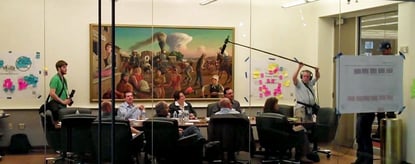 After speaking on "Strategic Thinking for Market Researchers" at last year's IIR The Market Research Event, I attended a session which discussed “creative consumers.” They were nearly reverently described as “consumers” serving as paid innovation session participants; this, after passing personality tests (both oral and written) and receiving creativity technique training. "Creative consumers" were lauded for being able to write dead-on concept statements.
After speaking on "Strategic Thinking for Market Researchers" at last year's IIR The Market Research Event, I attended a session which discussed “creative consumers.” They were nearly reverently described as “consumers” serving as paid innovation session participants; this, after passing personality tests (both oral and written) and receiving creativity technique training. "Creative consumers" were lauded for being able to write dead-on concept statements.
- The best facilitated innovation sessions don’t require 50% creatives. At 20% of participants, creative people can really drive creative instigation while remaining participants contribute to other business strategy issues being explored. Going higher saps the diversity critical for innovative ideas.
- Lack of diversity can hamper the strategy evaluation phase. Interestingly, two later rejected innovation concepts shared to demonstrate the group’s creativity both fell apart based on density requirements. Not enough volume in a certain time period usually signals major problems. Density isn’t necessarily a strategic principle driving CPG, but it’s a challenge readily apparent to service marketing professionals since time is a perishable resource which can’t be inventoried. Here's where a little more strategic diversity in an innovation group could have been beneficial.
- One hundred fifty-four ideas isn’t a remarkable a number of new ideas. We’ve seen 500 or 600 ideas from a more diverse participant group in innovation sessions we've facilitated. The number of new ideas is highly dependent on what an innovation session's strategic objectives are and using the right creativity tools to help realize your business goals.
- It’s ridiculous to call these participants “consumers.” While companies want to feel they’re involving real consumers in the innovation process, that’s suspect. They may have familiarity and experience in the topic. But with the testing, innovation training, and pay involved ($500-$1500 daily), they’re really “part-time, informal creative staff members.” Seventeen years in, somebody doesn’t enter a session with a completely fresh innovative “consumer” perspective.
This is an intriguing innovation concept, but appears to be misrepresented and oversold. The funniest moment was during Q&A when someone asked apprehensively if the creative consumers could travel. I turned to the guy next to me and asked, “I wonder what they eat?”
Probably special pellets to generate creative sparks! – Mike Brown
The Brainzooming Group helps make smart organizations more successful by rapidly expanding their strategic options and creating innovative plans they can efficiently implement. Email us at brainzooming@gmail.com or call 816-509-5320 to learn how we can deliver strategic, innovative, implementable ideas for your organization.



